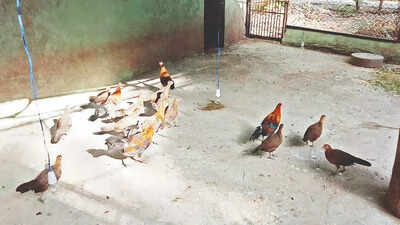- News
- City News
- rajkot News
- Gujarat’s jungles to get back near-extinct bird red fowl
Trending Topics
Gujarat’s jungles to get back near-extinct bird red fowl

Nearly 100 chicks of the fowl have been successfully hatched at Sakkarbaug zoo in Junagadh
RAJKOT: Gujarat’s jungles will be reintroduced to the near-extinct feathered friend, the red jungle fowl. Subjected to human cupidity, both in terms of its narrowing habitats and rampant poaching, the bird species nearly vanished from the state.
However, thanks to the successful conservation programme by Sakkarbaug zoo in Junagadh, 100 chicks of the fowl have been successfully hatched in captive breeding, which are proposed to be freed in their natural habitats once again.
According to the forest department, six pairs of red jungle fowl were kept for captive breeding in 2020-21. This produced F-1 generation of 50 chicks in 2021-22. In the past two years, the fowl population rose to 100 chicks from the programme conceived in 2017 and finally delivered 2020-21.
Akshay Joshi Deputy conservator of forest, Sakkarbaug zoo said, “We have provided the fowls with a conducive environment and proper food for natural breeding. We also started artificial insemination at the Sakkarbaug zoo, which resulted in a successful higher fertility rate.”
Joshi further said that in order to conserve the declining red jungle fowl population in Gujarat, the government decided to start a programme to reintroduce the bird into the wild.
The zoo gave around 25 birds to the forest officials of Banaskantha to release them into the wild, where they seen in the past. It has also asked for a report on the successful breeding of the fowls in nature after release.
“The main reason of the bird’s extinction is poaching,” said Prasad Gunpule, an ornithologist. He said that while it is sighted in some parts of North India, it is rarely seen in Gujarat. “They have fallen prey to poachers because of their ground-dwelling habit. The other reason is loss of habitat owing to increasing human population and reducing forest areas,” he said.
There is, however, no official record of the bird’s census or exact details of its distribution area. Ornithologists are, therefore, worried about the reintroduction of this bird in the wild and its welfare. But looking at the special efforts taken by the forest department, they are also optimistic of a positive outcome.
However, thanks to the successful conservation programme by Sakkarbaug zoo in Junagadh, 100 chicks of the fowl have been successfully hatched in captive breeding, which are proposed to be freed in their natural habitats once again.
According to the forest department, six pairs of red jungle fowl were kept for captive breeding in 2020-21. This produced F-1 generation of 50 chicks in 2021-22. In the past two years, the fowl population rose to 100 chicks from the programme conceived in 2017 and finally delivered 2020-21.
Akshay Joshi Deputy conservator of forest, Sakkarbaug zoo said, “We have provided the fowls with a conducive environment and proper food for natural breeding. We also started artificial insemination at the Sakkarbaug zoo, which resulted in a successful higher fertility rate.”
Joshi further said that in order to conserve the declining red jungle fowl population in Gujarat, the government decided to start a programme to reintroduce the bird into the wild.
The zoo gave around 25 birds to the forest officials of Banaskantha to release them into the wild, where they seen in the past. It has also asked for a report on the successful breeding of the fowls in nature after release.
“The main reason of the bird’s extinction is poaching,” said Prasad Gunpule, an ornithologist. He said that while it is sighted in some parts of North India, it is rarely seen in Gujarat. “They have fallen prey to poachers because of their ground-dwelling habit. The other reason is loss of habitat owing to increasing human population and reducing forest areas,” he said.
There is, however, no official record of the bird’s census or exact details of its distribution area. Ornithologists are, therefore, worried about the reintroduction of this bird in the wild and its welfare. But looking at the special efforts taken by the forest department, they are also optimistic of a positive outcome.

About the Author
Nimesh KhakhariyaNimesh Khakhariya is an assistant editor with Times Of India.
Start a Conversation
FOLLOW US ON SOCIAL MEDIA
FacebookTwitterInstagramKOO APPYOUTUBE







